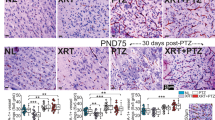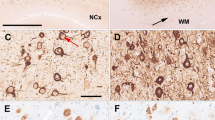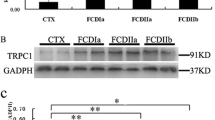Abstract
Focal cortical dysplasia (FCD), a common malformation of cortical development, is frequently associated with pharmacoresistant epilepsy in both children and adults. Adenosine is an inhibitory modulator of brain activity and a prospective anti-seizure agent with potential for clinical translation. Our previous results demonstrated that the major adenosine-metabolizing enzyme adenosine kinase (ADK) was upregulated in balloon cells (BCs) within FCD type IIB lesions, suggesting that dysfunction of the adenosine system is implicated in the pathophysiology of FCD. In our current study, we therefore performed a comprehensive analysis of adenosine signaling in surgically resected cortical specimens from patients with FCD type I and type II via immunohistochemistry and immunoblot analysis. Adenosine enzyme signaling was assessed by quantifying the levels of the key enzymes of adenosine metabolism, i.e., ADK, adenosine deaminase (ADA), and ecto-5'-nucleotidase (CD73). Adenosine receptor signaling was assessed by quantifying the levels of adenosine A2A receptor (A2AR) and putative downstream mediators of adenosine, namely, glutamate transporter-1 (GLT-1) and mammalian target of rapamycin (mTOR). Within lesions in FCD specimens, we found that the adenosine-metabolizing enzymes ADK and ADA, as well as the adenosine-producing enzyme CD73, were upregulated. We also observed an increase in A2AR density, as well as a decrease in GLT-1 levels and an increase in mTOR levels, in FCD specimens compared with control tissue. These results suggest that dysregulation of the adenosine system is a common pathologic feature of both FCD type I and type II. The adenosine system might therefore be a therapeutic target for the treatment of epilepsy associated with FCD.













Similar content being viewed by others
Data Availability
The datasets generated in the current research are available from the corresponding authors on reasonable request.
References
Crino PB (2015) Focal Cortical Dysplasia. Seminars Neurol 35(3):201–8. https://doi.org/10.1055/s-0035-1552617
Blümcke I, Thom M, Aronica E et al (2011) The clinicopathologic spectrum of focal cortical dysplasias: a consensus classification proposed by an ad hoc Task Force of the ILAE Diagnostic Methods Commission. Epilepsia. 52(1):158–74. https://doi.org/10.1111/j.1528-1167.2010.02777.x
Tassi L, Garbelli R, Colombo N et al (2010) Type I focal cortical dysplasia: surgical outcome is related to histopathology. Epileptic Dis : Int Epilepsy J Videotape. 12(3):181–91. https://doi.org/10.1684/epd.2010.0327
Guerrini R, Duchowny M, Jayakar P et al (2015) Diagnostic methods and treatment options for focal cortical dysplasia. Epilepsia. 56(11):1669–86. https://doi.org/10.1111/epi.13200
Tassi L, Colombo N, Garbelli R et al (2002) Focal cortical dysplasia: neuropathological subtypes, EEG, neuroimaging and surgical outcome. Brain : J Neurol 125(Pt 8):1719–32. https://doi.org/10.1093/brain/awf175
Lim JS, Kim WI, Kang HC et al (2015) Brain somatic mutations in MTOR cause focal cortical dysplasia type II leading to intractable epilepsy. Nat Med 21(4):395–400. https://doi.org/10.1038/nm.3824
Nakashima M, Saitsu H, Takei N et al (2015) Somatic Mutations in the MTOR gene cause focal cortical dysplasia type IIb. Ann Neurol 78(3):375–86. https://doi.org/10.1002/ana.24444
Weichhart T, Säemann MD (2009) The multiple facets of mTOR in immunity. Trends Immunol 30(5):218–26. https://doi.org/10.1016/j.it.2009.02.002
Maldonado M, Baybis M, Newman D et al (2003) Expression of ICAM-1, TNF-alpha, NF kappa B, and MAP kinase in tubers of the tuberous sclerosis complex. Neurobiol Dis 14(2):279–90. https://doi.org/10.1016/s0969-9961(03)00127-x
Boer K, Spliet WG, van Rijen PC, Redeker S, Troost D, Aronica E (2006) Evidence of activated microglia in focal cortical dysplasia. J Neuroimmunol 173(1–2):188–95. https://doi.org/10.1016/j.jneuroim.2006.01.002
Cepeda C, André VM, Levine MS et al (2006) Epileptogenesis in pediatric cortical dysplasia: the dysmature cerebral developmental hypothesis. Epilepsy Behavior : E&B. 9(2):219–35. https://doi.org/10.1016/j.yebeh.2006.05.012
Hammers A, Koepp MJ, Richardson MP et al (2001) Central benzodiazepine receptors in malformations of cortical development: A quantitative study. Brain : J Neurol 124(Pt 8):1555–65. https://doi.org/10.1093/brain/124.8.1555
Luan G, Gao Q, Zhai F et al (2015) Adenosine kinase expression in cortical dysplasia with balloon cells: analysis of developmental lineage of cell types. J Neuropathol Exp Neurol 74(2):132–47. https://doi.org/10.1097/nen.0000000000000156
Li T, Ren G, Lusardi T et al (2008) Adenosine kinase is a target for the prediction and prevention of epileptogenesis in mice. J Clin Investig 118(2):571–82. https://doi.org/10.1172/jci33737
Masino SA, Li T, Theofilas P et al (2011) A ketogenic diet suppresses seizures in mice through adenosine A1 receptors. J Clin Investig 121(7):2679–83. https://doi.org/10.1172/jci57813
Li T, Quan Lan J, Fredholm BB, Simon RP, Boison D (2007) Adenosine dysfunction in astrogliosis: cause for seizure generation? Neuron glia Biol 3(4):353–66. https://doi.org/10.1017/s1740925x0800015x
Moschovos C, Kostopoulos G, Papatheodoropoulos C (2012) Endogenous adenosine induces NMDA receptor-independent persistent epileptiform discharges in dorsal and ventral hippocampus via activation of A2 receptors. Epilepsy Res 100(1–2):157–67. https://doi.org/10.1016/j.eplepsyres.2012.02.012
Boison D (2016) Adenosinergic signaling in epilepsy. Neuropharmacology. 104:131–9. https://doi.org/10.1016/j.neuropharm.2015.08.046
Guo M, Li T (2022) Adenosine Dysfunction in Epilepsy and Associated Comorbidities. Curr Drug Targets 23(4):344–357. https://doi.org/10.2174/1389450122666210928145258
Guo M, Xie P, Liu S, Luan G, Li T (2022) Epilepsy and Autism Spectrum Disorder (ASD): The underlying Mechanisms and Therapy Targets related with Adenosine. Curr Neuropharmacol. https://doi.org/10.2174/1570159x20666220706100136
Lopes LV, Cunha RA, Kull B, Fredholm BB, Ribeiro JA (2002) Adenosine A(2A) receptor facilitation of hippocampal synaptic transmission is dependent on tonic A(1) receptor inhibition. Neuroscience. 112(2):319–29. https://doi.org/10.1016/s0306-4522(02)00080-5
Matos M, Augusto E, Agostinho P, Cunha RA, Chen JF (2013) Antagonistic interaction between adenosine A2A receptors and Na+/K+-ATPase-α2 controlling glutamate uptake in astrocytes. J Neurosci : Off J Soc Neurosci 33(47):18492–502. https://doi.org/10.1523/jneurosci.1828-13.2013
Gonçalves FQ, Lopes JP, Silva HB et al (2019) Synaptic and memory dysfunction in a β-amyloid model of early Alzheimer’s disease depends on increased formation of ATP-derived extracellular adenosine. Neurobiol Dis 132:104570. https://doi.org/10.1016/j.nbd.2019.104570
Stockwell J, Jakova E, Cayabyab FS (2017) Adenosine A1 and A2A Receptors in the Brain: Current Research and Their Role in Neurodegeneration. Molecules (Basel, Switzerland). 22(4)https://doi.org/10.3390/molecules22040676
Matos M, Augusto E, Santos-Rodrigues AD et al (2012) Adenosine A2A receptors modulate glutamate uptake in cultured astrocytes and gliosomes. Glia. 60(5):702–16. https://doi.org/10.1002/glia.22290
Matos M, Shen HY, Augusto E et al (2015) Deletion of adenosine A2A receptors from astrocytes disrupts glutamate homeostasis leading to psychomotor and cognitive impairment: relevance to schizophrenia. Biol Psych 78(11):763–74. https://doi.org/10.1016/j.biopsych.2015.02.026
He X, Chen F, Zhang Y et al (2020) Upregulation of adenosine A2A receptor and downregulation of GLT1 is associated with neuronal cell death in Rasmussen’s encephalitis. Brain Pathol (Zurich, Switzerland). 30(2):246–260. https://doi.org/10.1111/bpa.12770
Boison D (2008) The adenosine kinase hypothesis of epileptogenesis. Progress Neurobiol 84(3):249–62. https://doi.org/10.1016/j.pneurobio.2007.12.002
Boison D (2012) Adenosine dysfunction in epilepsy. Glia. 60(8):1234–1243
Li T, Lytle N, Lan JQ, Sandau US, Boison D (2012) Local disruption of glial adenosine homeostasis in mice associates with focal electrographic seizures: a first step in epileptogenesis? Glia. 60(1):83–95. https://doi.org/10.1002/glia.21250
de Groot M, Iyer A, Zurolo E et al (2012) Overexpression of ADK in human astrocytic tumors and peritumoral tissue is related to tumor-associated epilepsy. Epilepsia. 53(1):58–66. https://doi.org/10.1111/j.1528-1167.2011.03306.x
Zhang Y, Wang X, Tang C et al (2022) Genetic variations of adenosine kinase as predictable biomarkers of efficacy of vagus nerve stimulation in patients with pharmacoresistant epilepsy. J Neurosurg. 136(3):726–735. https://doi.org/10.3171/2021.3.JNS21141
Luan G, Gao Q, Guan Y et al (2013) Upregulation of adenosine kinase in Rasmussen encephalitis. J Neuropathol Exp Neurol 72(11):1000–8. https://doi.org/10.1097/01.jnen.0000435369.39388.5c
Luan G, Wang X, Gao Q et al (2017) Upregulation of Neuronal Adenosine A1 Receptor in Human Rasmussen Encephalitis. J Neuropathol Exp Neurol 76(8):720–731. https://doi.org/10.1093/jnen/nlx053
Glass M, Faull RL, Bullock JY et al (1996) Loss of A1 adenosine receptors in human temporal lobe epilepsy. Brain Res. 710(1–2):56–68
Boison D (2013) Adenosine kinase: exploitation for therapeutic gain. Pharmacol Rev 65(3):906–43. https://doi.org/10.1124/pr.112.006361
Shi L, Wu Z, Miao J et al (2019) Adenosine interaction with adenosine receptor A2a promotes gastric cancer metastasis by enhancing PI3K-AKT-mTOR signaling. Mole Biol Cell 30(19):2527–2534. https://doi.org/10.1091/mbc.E19-03-0136
Liu G, Yang S, Liu Y et al (2022) The adenosine-A2a receptor regulates the radioresistance of gastric cancer via PI3K-AKT-mTOR pathway. Int J Clin Oncol 27(5):911–920. https://doi.org/10.1007/s10147-022-02123-x
Palmini A, Najm I, Avanzini G et al (2004) Terminology and classification of the cortical dysplasias. Neurology. 62(6 Suppl 3):S2-8. https://doi.org/10.1212/01.wnl.0000114507.30388.7e
Luan G, Gao Q, Zhai F, Chen Y, Li T (2016) Upregulation of HMGB1, toll-like receptor and RAGE in human Rasmussen’s encephalitis. Epilepsy Res 123:36–49. https://doi.org/10.1016/j.eplepsyres.2016.03.005
Bautista JF, Lüders HO (2000) Semiological seizure classification: relevance to pediatric epilepsy. Epileptic Disord : Int epilepsy J Videotape. 2(1):65-72; discussion 73
Lüders H, Acharya J, Baumgartner C et al (1998) Semiological seizure classification. Epilepsia. 39(9):1006–13. https://doi.org/10.1111/j.1528-1157.1998.tb01452.x
Li T, Steinbeck JA, Lusardi T et al (2007) Suppression of kindling epileptogenesis by adenosine releasing stem cell-derived brain implants. Brain : J Neurol 130(Pt 5):1276–88. https://doi.org/10.1093/brain/awm057
Yegutkin GG, Boison D (2022) ATP and Adenosine Metabolism in Cancer: Exploitation for Therapeutic Gain. Pharmacol Rev 74(3):797–822. https://doi.org/10.1124/pharmrev.121.000528
Boison D, Yegutkin GG (2019) Adenosine metabolism: emerging concepts for cancer therapy. Cancer Cell 36:582–596
During MJ, Spencer DD (1992) Adenosine: a potential mediator of seizure arrest and postictal refractoriness. Ann Neurol 32(5):618–24
Boison D, Chen JF, Fredholm BB (2010) Adenosine signaling and function in glial cells. Cell Death Differ. 17(7):1071–82. https://doi.org/10.1038/cdd.2009.131
Fedele DE, Koch P, Brüstle O et al (2004) Engineering embryonic stem cell derived glia for adenosine delivery. Neurosci Lett. 370(2–3):160–165
Patodia S, Paradiso B, Garcia M et al (2020) Adenosine kinase and adenosine receptors A(1) R and A(2A) R in temporal lobe epilepsy and hippocampal sclerosis and association with risk factors for SUDEP. Epilepsia. 61(4):787–797. https://doi.org/10.1111/epi.16487
Aronica E, Zurolo E, Iyer A et al (2011) Upregulation of adenosine kinase in astrocytes in experimental and human temporal lobe epilepsy. Epilepsia. 52(9):1645–55. https://doi.org/10.1111/j.1528-1167.2011.03115.x
Cui XA, Singh B, Park J, Gupta RS (2009) Subcellular localization of adenosine kinase in mammalian cells: The long isoform of AdK is localized in the nucleus. Biochem Biophys Res Commun 388(1):46–50. https://doi.org/10.1016/j.bbrc.2009.07.106
Aronica E, Sandau US, Iyer A, Boison D (2013) Glial adenosine kinase–a neuropathological marker of the epileptic brain. Neurochem Int 63(7):688–95. https://doi.org/10.1016/j.neuint.2013.01.028
Studer FE, Fedele DE, Marowsky A, et al (2006) Shift of adenosine kinase expression from neurons to astrocytes during postnatal development suggests dual functionality of the enzyme. Neuroscience. 142(1):125-37. S0306-4522(06)00812-8 [pii] https://doi.org/10.1016/j.neuroscience.2006.06.016
Gomez-Castro F, Zappettini S, Pressey JC et al (2021) Convergence of adenosine and GABA signaling for synapse stabilization during development. Science (New York, NY) 374(6568):eabk2055. https://doi.org/10.1126/science.abk2055
Silva CG, Métin C, Fazeli W et al (2013) Adenosine receptor antagonists including caffeine alter fetal brain development in mice. Sci Transl Med 5(197):197ra104. https://doi.org/10.1126/scitranslmed.3006258
Alçada-Morais S, Gonçalves N, Moreno-Juan V et al (1991) 2021 Adenosine A2A Receptors Contribute to the Radial Migration of Cortical Projection Neurons through the Regulation of Neuronal Polarization and Axon Formation. Cerebral Cortex (New York, NY 1991) 31(12):5652–5663. https://doi.org/10.1093/cercor/bhab188
Barros-Barbosa AR, Ferreirinha F, Oliveira  et al (2016) Adenosine A(2A) receptor and ecto-5’-nucleotidase/CD73 are upregulated in hippocampal astrocytes of human patients with mesial temporal lobe epilepsy (MTLE). Purinergic Signal 12(4):719–734. https://doi.org/10.1007/s11302-016-9535-2
Silva CG, Porciúncula LO, Canas PM, Oliveira CR, Cunha RA (2007) Blockade of adenosine A(2A) receptors prevents staurosporine-induced apoptosis of rat hippocampal neurons. Neurobiol Dis 27(2):182–9. https://doi.org/10.1016/j.nbd.2007.04.018
Popoli P, Frank C, Tebano MT et al (2003) Modulation of glutamate release and excitotoxicity by adenosine A2A receptors. Neurology. 61(11 Suppl 6):S69-71. https://doi.org/10.1212/01.wnl.0000095216.89483.a2
D’Alimonte I, D’Auro M, Citraro R et al (2009) Altered distribution and function of A2A adenosine receptors in the brain of WAG/Rij rats with genetic absence epilepsy, before and after appearance of the disease. Eur J Neurosci 30(6):1023–35. https://doi.org/10.1111/j.1460-9568.2009.06897.x
Li X, Kang H, Liu X, et al 2012 Effect of adenosine A2A receptor antagonist ZM241385 on amygdala-kindled seizures and progression of amygdala kindling. Journal of Huazhong University of Science and Technology Medical sciences = Hua zhong ke ji da xue xue bao Yi xue Ying De wen ban = Huazhong keji daxue xuebao Yixue Yingdewen ban. 32(2):257-264. https://doi.org/10.1007/s11596-012-0046-2
Tescarollo FC, Rombo DM, DeLiberto LK et al (2020) Role of Adenosine in Epilepsy and Seizures. J Caffeine Adenosine Res 10(2):45–60. https://doi.org/10.1089/caff.2019.0022
Xu X, Beleza RO, Gonçalves FQ et al (2022) Adenosine A(2A) receptors control synaptic remodeling in the adult brain. Sci Rep 12(1):14690. https://doi.org/10.1038/s41598-022-18884-4
El Yacoubi M, Ledent C, Parmentier M, Daoust M, Costentin J, Vaugeois J (2001) Absence of the adenosine A(2A) receptor or its chronic blockade decrease ethanol withdrawal-induced seizures in mice. Neuropharmacology. 40(3):424–32. https://doi.org/10.1016/s0028-3908(00)00173-8
El Yacoubi M, Ledent C, Parmentier M, Costentin J, Vaugeois JM (2008) Evidence for the involvement of the adenosine A(2A) receptor in the lowered susceptibility to pentylenetetrazol-induced seizures produced in mice by long-term treatment with caffeine. Neuropharmacology. 55(1):35–40. https://doi.org/10.1016/j.neuropharm.2008.04.007
Hosseinmardi N, Mirnajafi-Zadeh J, Fathollahi Y, Shahabi P (2007) The role of adenosine A1 and A2A receptors of entorhinal cortex on piriform cortex kindled seizures in rats. Pharmacol Res 56(2):110–7. https://doi.org/10.1016/j.phrs.2007.04.011
Zeraati M, Mirnajafi-Zadeh J, Fathollahi Y, Namvar S, Rezvani ME (2006) Adenosine A1 and A2A receptors of hippocampal CA1 region have opposite effects on piriform cortex kindled seizures in rats. Seizure. 15(1):41–8. https://doi.org/10.1016/j.seizure.2005.10.006
Etherington LA, Frenguelli BG (2004) Endogenous adenosine modulates epileptiform activity in rat hippocampus in a receptor subtype-dependent manner. Eur J Neurosci 19(9):2539–50. https://doi.org/10.1111/j.0953-816X.2004.03355.x
El Yacoubi M, Ledent C, Parmentier M, Costentin J, Vaugeois JM (2009) Adenosine A2A receptor deficient mice are partially resistant to limbic seizures. Naunyn-Schmiedeberg’s arch Pharmacol 380(3):223–32. https://doi.org/10.1007/s00210-009-0426-8
Lopes LV, Cunha RA, Ribeiro JA (1999) Cross talk between A(1) and A(2A) adenosine receptors in the hippocampus and cortex of young adult and old rats. J Neurophysiol 82(6):3196–203. https://doi.org/10.1152/jn.1999.82.6.3196
Canas PM, Porciúncula LO, Simões AP, et al (2018) Neuronal Adenosine A2A Receptors Are Critical Mediators of Neurodegeneration Triggered by Convulsions. eNeuro. 5(6) https://doi.org/10.1523/eneuro.0385-18.2018
Cunha RA (2016) How does adenosine control neuronal dysfunction and neurodegeneration? J Neurochem 139(6):1019–1055. https://doi.org/10.1111/jnc.13724
Gomes CV, Kaster MP, Tome AR, Agostinho PM, Cunha RA (2011) Adenosine receptors and brain diseases: neuroprotection and neurodegeneration. Biochim Biophys Acta. May 1808(5):1380-99. S0005-2736(10)00423-2 [pii] https://doi.org/10.1016/j.bbamem.2010.12.001
Benarroch EE (2010) Glutamate transporters: diversity, function, and involvement in neurologic disease. Neurology. 74(3):259–64. https://doi.org/10.1212/WNL.0b013e3181cc89e3
Aronica E, van Vliet EA, Hendriksen E, Troost D, Lopes da Silva FH, Gorter JA (2001) Cystatin C, a cysteine protease inhibitor, is persistently up-regulated in neurons and glia in a rat model for mesial temporal lobe epilepsy. The European journal of neuroscience 14(9):1485–91. https://doi.org/10.1046/j.0953-816x.2001.01779.x
Beach TG, Woodhurst WB, MacDonald DB, Jones MW (1995) Reactive microglia in hippocampal sclerosis associated with human temporal lobe epilepsy. Neurosci Lett 191(1–2):27–30. https://doi.org/10.1016/0304-3940(94)11548-1
Niquet J, Ben-Ari Y, Represa A (1994) Glial reaction after seizure induced hippocampal lesion: immunohistochemical characterization of proliferating glial cells. J Neurocytol 23(10):641–56. https://doi.org/10.1007/bf01191558
Taniwaki Y, Kato M, Araki T, Kobayashi T (1996) Microglial activation by epileptic activities through the propagation pathway of kainic acid-induced hippocampal seizures in the rat. Neurosci Lett 217(1):29–32. https://doi.org/10.1016/0304-3940(96)13062-7
Aronica E, Gorter JA, Redeker S et al (2005) Distribution, characterization and clinical significance of microglia in glioneuronal tumours from patients with chronic intractable epilepsy. Neuropathol Appl Neurobiol 31(3):280–91. https://doi.org/10.1111/j.1365-2990.2004.00636.x
Iffland PH 2nd, Crino PB (2017) Focal Cortical Dysplasia: Gene Mutations, Cell Signaling, and Therapeutic Implications. Ann Rev Pathol 12:547–571. https://doi.org/10.1146/annurev-pathol-052016-100138
Mossmann D, Park S, Hall MN (2018) mTOR signalling and cellular metabolism are mutual determinants in cancer. Nat Rev Cancer. 18(12):744–757. https://doi.org/10.1038/s41568-018-0074-8
Curatolo P, Moavero R, van Scheppingen J, Aronica E (2018) mTOR dysregulation and tuberous sclerosis-related epilepsy. Exp Rev Neurotherapeut 18(3):185–201. https://doi.org/10.1080/14737175.2018.1428562
Hodges SL, Lugo JN (2020) Therapeutic role of targeting mTOR signaling and neuroinflammation in epilepsy. Epilepsy Res 161:106282. https://doi.org/10.1016/j.eplepsyres.2020.106282
Inoki K, Kim J, Guan KL (2012) AMPK and mTOR in cellular energy homeostasis and drug targets. Ann Rev Pharmacol Toxicol 52:381–400. https://doi.org/10.1146/annurev-pharmtox-010611-134537
Yan Y, Mukherjee S, Harikumar KG et al (2021) Structure of an AMPK complex in an inactive, ATP-bound state. Science (New York, NY). 373(6553):413–419. https://doi.org/10.1126/science.abe7565
Marsan E, Baulac S (2018) Review: Mechanistic target of rapamycin (mTOR) pathway, focal cortical dysplasia and epilepsy. Neuropathol Appl Neurobiol 44(1):6–17. https://doi.org/10.1111/nan.12463
Ljungberg MC, Bhattacharjee MB, Lu Y et al (2006) Activation of mammalian target of rapamycin in cytomegalic neurons of human cortical dysplasia. Ann Neurol 60(4):420–9. https://doi.org/10.1002/ana.20949
Liu J, Reeves C, Michalak Z et al (2014) Evidence for mTOR pathway activation in a spectrum of epilepsy-associated pathologies. Acta Neuropathol Commun 2:71. https://doi.org/10.1186/2051-5960-2-71
Acknowledgments
This work was supported by the National Natural Science Foundation of China (grant numbers 81571275 and 11932003) and the National Institutes of Health (grant numbers NS065957, NS103740, and NS127846).
Funding
This work was supported by the National Natural Science Foundation of China (grant numbers 81571275 and 11932003) and the National Institutes of Health (grant numbers NS065957, NS103740, and NS127846).
Author information
Authors and Affiliations
Contributions
All authors contributed to the study conception and design. The overall experimental design was conceived and supervised by Tianfu Li and Guoming Luan; Mengyi Guo, Jing Zhang, Jing Wang and Xiongfei Wang helped Tianfu Li and Guoming Luan in drafting and preparing the manuscript for submission; Immunohistochemistry, western blot, as well as the analysis of the data were performed by Mengyi Guo, Jing Zhang, Jing Wang, Chongyang Tang, Jiahui Deng, Zhonghua Xiong and Xiangru Kong; Yuguang Guan and Jian Zhou helped in the selection and collection of brain tissues; Detlev Boison provided advice and co-wrote the manuscript. All authors read and approved the final manuscript.
Corresponding authors
Ethics declarations
Competing Interests
The authors have no relevant financial or non-financial interests to disclose.
Ethics Approval
This study was performed in line with the principles of the Declaration of Helsinki. Approval was granted by the local ethics committee (Beijing Sanbo Hospital, Capital Medical University, Beijing, China).
Consent for Publication
Not applicable.
Consent to Participate
Informed consent was obtained from parents or legal guardians of all participants.
Additional information
Publisher's Note
Springer Nature remains neutral with regard to jurisdictional claims in published maps and institutional affiliations.
Rights and permissions
Springer Nature or its licensor (e.g. a society or other partner) holds exclusive rights to this article under a publishing agreement with the author(s) or other rightsholder(s); author self-archiving of the accepted manuscript version of this article is solely governed by the terms of such publishing agreement and applicable law.
About this article
Cite this article
Guo, M., Zhang, J., Wang, J. et al. Aberrant adenosine signaling in patients with focal cortical dysplasia. Mol Neurobiol 60, 4396–4417 (2023). https://doi.org/10.1007/s12035-023-03351-6
Received:
Accepted:
Published:
Issue Date:
DOI: https://doi.org/10.1007/s12035-023-03351-6




